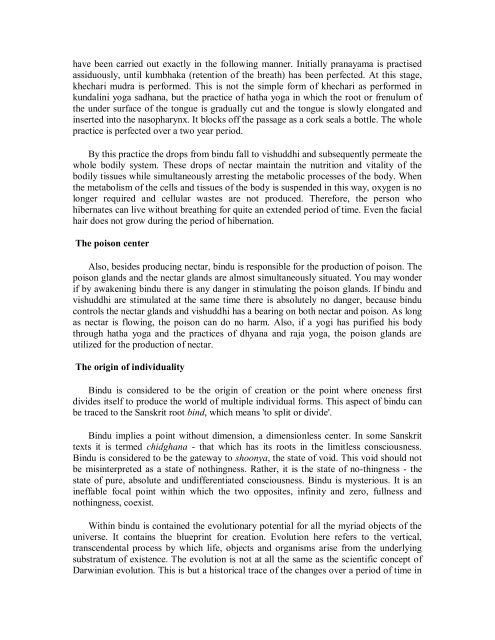Kundalini.Tantra.by.Satyananda.Saraswati
Create successful ePaper yourself
Turn your PDF publications into a flip-book with our unique Google optimized e-Paper software.
have been carried out exactly in the following manner. Initially pranayama is practised<br />
assiduously, until kumbhaka (retention of the breath) has been perfected. At this stage,<br />
khechari mudra is performed. This is not the simple form of khechari as performed in<br />
kundalini yoga sadhana, but the practice of hatha yoga in which the root or frenulum of<br />
the under surface of the tongue is gradually cut and the tongue is slowly elongated and<br />
inserted into the nasopharynx. It blocks off the passage as a cork seals a bottle. The whole<br />
practice is perfected over a two year period.<br />
By this practice the drops from bindu fall to vishuddhi and subsequently permeate the<br />
whole bodily system. These drops of nectar maintain the nutrition and vitality of the<br />
bodily tissues while simultaneously arresting the metabolic processes of the body. When<br />
the metabolism of the cells and tissues of the body is suspended in this way, oxygen is no<br />
longer required and cellular wastes are not produced. Therefore, the person who<br />
hibernates can live without breathing for quite an extended period of time. Even the facial<br />
hair does not grow during the period of hibernation.<br />
The poison center<br />
Also, besides producing nectar, bindu is responsible for the production of poison. The<br />
poison glands and the nectar glands are almost simultaneously situated. You may wonder<br />
if <strong>by</strong> awakening bindu there is any danger in stimulating the poison glands. If bindu and<br />
vishuddhi are stimulated at the same time there is absolutely no danger, because bindu<br />
controls the nectar glands and vishuddhi has a bearing on both nectar and poison. As long<br />
as nectar is flowing, the poison can do no harm. Also, if a yogi has purified his body<br />
through hatha yoga and the practices of dhyana and raja yoga, the poison glands are<br />
utilized for the production of nectar.<br />
The origin of individuality<br />
Bindu is considered to be the origin of creation or the point where oneness first<br />
divides itself to produce the world of multiple individual forms. This aspect of bindu can<br />
be traced to the Sanskrit root bind, which means 'to split or divide'.<br />
Bindu implies a point without dimension, a dimensionless center. In some Sanskrit<br />
texts it is termed chidghana - that which has its roots in the limitless consciousness.<br />
Bindu is considered to be the gateway to shoonya, the state of void. This void should not<br />
be misinterpreted as a state of nothingness. Rather, it is the state of no-thingness - the<br />
state of pure, absolute and undifferentiated consciousness. Bindu is mysterious. It is an<br />
ineffable focal point within which the two opposites, infinity and zero, fullness and<br />
nothingness, coexist.<br />
Within bindu is contained the evolutionary potential for all the myriad objects of the<br />
universe. It contains the blueprint for creation. Evolution here refers to the vertical,<br />
transcendental process <strong>by</strong> which life, objects and organisms arise from the underlying<br />
substratum of existence. The evolution is not at all the same as the scientific concept of<br />
Darwinian evolution. This is but a historical trace of the changes over a period of time in














![[Lonely Planet] Sri Lanka](https://img.yumpu.com/59845622/1/169x260/lonely-planet-sri-lanka.jpg?quality=85)


